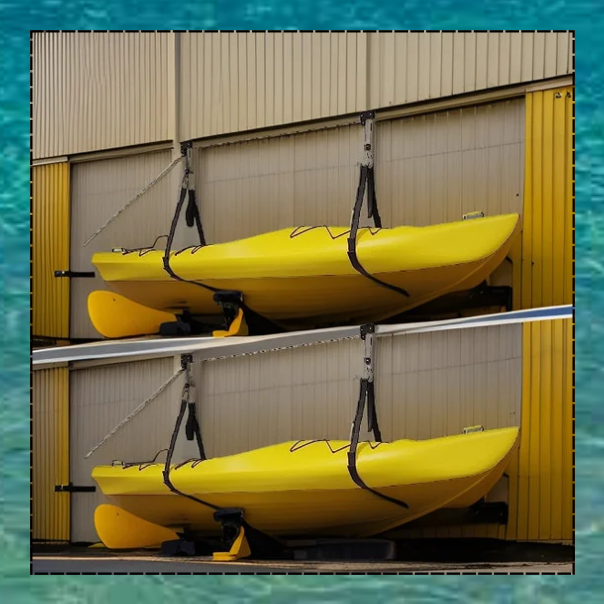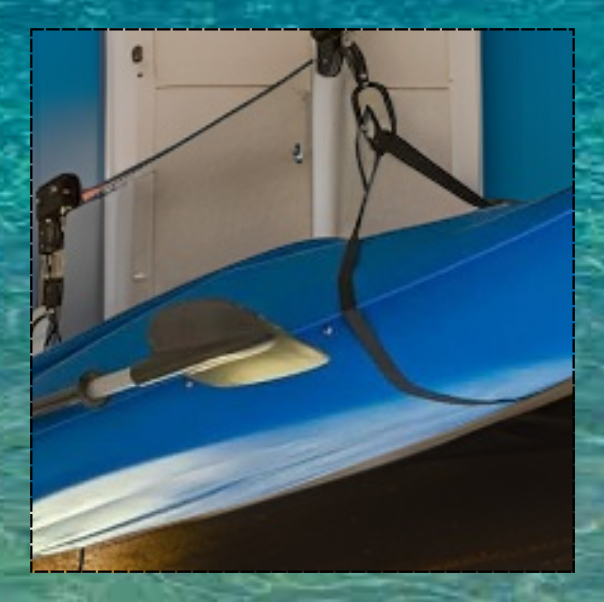==================
Florida Splendors is supported by our audience. When you purchase through one of our links, we may earn a small affiliate commission. As an Amazon Associate I earn from qualifying purchases. Your cost is not affected.
Owning a kayak opens the door to thrilling water adventures, but safeguarding your investment requires more than just dragging it into the garage. Improper storage can lead to warping, hull damage, mold, fading, and even theft.In this guide, we delve into the significance of good kayak storage practices, highlighting the importance of protecting your watercraft from damage, the elements, and potential theft. Whether you’re a seasoned kayaker or a new owner, understanding how to store your kayak properly is essential for maintaining its optimal condition.
Join us as we explore common mistakes to avoid, the best practices for kayak storage, and recommended kayak storage racks that can help you preserve your valuable asset for years of exciting adventures.
How to Store Your Kayak

People drag their kayaks straight from the water to their garages. They also leave them there for the winter. This storage technique could be better. Still, it can cause warping, hull damage, mold, fading, and theft. Do you have any idea how to store your kayak? And what is the best kayak storage rack?
Owning a kayak means you have spent a fair amount of your hard-earned money. So, it is your responsibility to keep and maintain its top shape for decades to enjoy more fun adventures. After buying, owners must learn how to store a kayak. After all, it requires some forethought.
An even weight distribution when storing your kayak is imperative. It should also hang or lean on a rack. Whether inside or outside, protect your boat from harm. After all, pest and rodent infestation can occur. Still, make an effort to prevent theft. Put it out of people’s sight.
Below, we’ll go over the best practices to help you with kayak storage. With these tips, you avoid common mistakes. It will help you figure out how to store a kayak to protect your valuable asset.
First, we will break down typical errors many new kayak owners make. After that, we will review the best ways to store a kayak.
Importance of Good Kayak Storage

Buying a kayak equates to ownership of expensive equipment. Because of this, it makes sense to be cautious when you store your kayak. Some most common reasons to store your kayak during the offseason include:
Protects Your Kayak from Damage and Deformity
Incorrect boat storage and uneven weight distribution can cause severe damage. According to professionals, weight should be equal in different areas. An issue with this may result in hull damage.
Shape distortion may not be apparent or visible right away. Rest assured, improper kayak storage for long periods can cause severe deformities. Many new kayak owners store their boats on their hulls. This condition misshapes or dents kayaks. Hence, it’s crucial to prevent this.
Besides storing your kayak on its hull, many other storage practices can also cause harm. The mistakes include the following:
- Standing the kayak on end is another practice that causes similar damage as when placed on its hull. It puts undue pressure on one back of your kayak, causing cracks while deforming the bow and stern shape.
- Another incorrect way to store your kayak is by hanging it from its straps. Remember that boatmakers created these grab handles for carrying a kayak. Yet, many people use these features to suspend their boats. This practice weakens straps, forcing them to erode and break. Moving a kayak from a vehicle to the shores can be difficult without these ties.
- Placing your kayak on a hard surface can be harmful during storage. Doing this can cause dents and scratches on several points meeting the boat’s surface.
Keeps Your Kayak from Elements
Your boat is always susceptible to damage. It can happen to vessels made of fiberglass, wood, plastic, or other materials. Quick or gradual exposure to the elements can disfigure it. Hence, it requires protection from rain, wind, frost, sunlight, and more.
- Sunlight: According to professionals, sunlight is the biggest culprit that degrades most materials. Plastic, fiberglass, wood, and other things can’t sustain damage. So, storing your kayak away from direct sunlight during the offseason is essential. You can store your kayak indoors, like in your garage or basement.
But, use a tarp for cover when you have limited space to store your kayak indoors. Likewise, ensure that there’s no contact between the boat and the tarp to prevent mold and fungus.
- Cold and Frost: Low and freezing temperatures threaten kayak integrity. Thus, it matters to store your kayak in a room-temperature place. When kept indoors, a cold spot can wreck a kayak. Extreme cold causes the water to freeze. The frozen liquid can go into the crevices and settle.
- Protective Spray: When storing outdoors, protect your kayak from UV rays. Use a sun-protective spray to do that. Drizzle your equipment twice a year, and then cover the entire kayak.
- Rain: If you don’t have an indoor space for safe storage, be ready for the rainy or snowy seasons. Seeping and settling water can make a kayak moldy. Repeated mold exposure results in gradual damage. A tarp helps protect your kayak. Yet, constant checking prevents or addresses moisture leakage. This method assures that your kayak is safe.
Protects Your Kayak from Potential Theft
The proper way to store your kayak helps protect it from off-season theft. As mentioned earlier, your kayak is a costly tool for fun and adventure. Make sure to keep it away from sight to prevent theft.
If you intend to store your kayak for a while, see that it remains available. Vigilance avoids theft. It would help to keep your kayak in a safe, locked place that only you and your family can access.
So, now let’s discuss how to store a kayak!
How to Store A Kayak

If you don’t know how to keep a kayak safely, follow the below steps:
1. Give Your Kayak A Thorough Cleaning
If your kayak is well-used, it will likely have a considerable share of dirt, residue, and bugs. It would help if you cleaned off all that stuff before storing your kayak. It would help if you carried your kayak into a shady area to start cleaning.
- Start removing the sections made of fabric. It includes storage compartments, seat cushions, and others. You can clean these parts separately. Once you have finished cleaning them, keep them dry and apart from the other components.
- Now, mix water and mild detergent and spray them on the kayak.
- Use a long scrub brush and start rinsing off the kayak with the hose. Make sure to thoroughly every nook and cranny.
- Now, open the drainage and let the water flow through it. Wait until all the water drains.
- Finally, carry your kayak back into a sunny spot and allow it to dry thoroughly. Also, ensure that all the storage spaces are open to dry.
2. Find A Place To Store Your Kayak
Kayaks stay indoors and away from the element and pests in an ideal environment. Yet, these water vessels only sometimes fit into a basement or a garage. So people often need to find suitable outdoor storage.
When Storing Your Kayak Outdoors

Many kayak owners cover their entire boat with a tarp and leave it outside. People must fix this technique. Also, the kayak storage method allows moisture to get underneath the tarp. This issue results in a kayak getting musty.
So how do you address the storage predicament? Keep your tarp from having a tight wrap on your boat. Instead, find a shady area where you can store your kayak. A DIY method uses a tarp and PVC pipes to create a tent-like structure. The construction lets the water drain off all sides.
Moreover, pay attention to the cockpit and protect your kayak from pests and rodents. Nowadays, finding a unique cover for wrapping a boat is easy.

What's Inside
Furthermore, when storing your kayak outdoors, also consider the following:
- Remove sections made of fabric. Get the seats and other removable parts with a cloth. Likewise, put them somewhere safe.
- Use a designated rack to store your kayak instead of leaving it on the ground.
- Make sure to keep your kayak away from direct sunlight. Constant exposure to UV rays produces severe damage to a kayak’s exterior.
-
Also, store your kayak in a secure, locked structure, like in your garage or shed.
When Storing Your Kayak Indoors
Most Recommended Ways to Store a Kayak
Here are a few top recommended ways to store your kayak:
1. Wooden Planks
Place two wooden planks close to the wall when storing your kayak on the surface. Now, ensure that the right side faces upward and the weight is even on the planks. Lift one end of your kayak to lean it against the wall. It will help spread the weight. To keep your kayak in its top shape, rotate it. Also, learn the other side of it to the wall each month.
2. Kayak Storage Racks
Kayak storage racks are almost always available on the market. But, if you want to avoid buying one, you can build a custom-designed one. These racks are great for placing your ship at a slight tilt on evenly distributed beams.
3. Hang the Kayak Using Bars or Straps
Another safe option to store your kayak is to hang it upside down using straps or bars anchored to the ceiling. Yet, make sure to avoid suspending your kayak from its handles.
Best Kayak Storage Racks
Below are some best kayak storage racks that you can use to safely store your kayak for extended periods.
1. Ajillis 71 Kayak Storage Rack
If you find stylish vehicles and a decorative garage appealing, choose the Ajillis 71. It may be your best kayak storage rack. Also, the freestanding kayak rack comes with a set of caster wheels. Hence, with it, you can store up to 6 kayaks. And it handles kayaks up to 11 feet in length. This portable kayak storage rack is efficient to use as well.

Features
- It has a floor stand.
- Attached to it are caster wheels.
- The angle on holding arms.
- It has padded foam storage arms.
2. RAD Wall-Mounted Kayak Storage Hooks
This wall-mounted kayak storage rack is flexible and straightforward to install. Because of its simple structure, you can mount it to any wall without breaking the bank. These square steel kayak storage racks are individual armatures. You can screw them in and place them wherever you want. Unlike competitors, these sport foam-covered hooks protect your kayak from scratches and nicks. The holding straps provide even more security.

Features
- It holds up to 125 pounds.
- It has rust-resistant powder-coated steel with foam-covered hooks.
- It can store more than one kayak.
- The unit has extreme durability.
3. RAD Sportz Freestanding Kayak Storage Rack

Features
- Customizable and versatile.
- Height and space adjustments.
- Padded arms.
- Rustproof.
- UV protection.
4. RAD Kayak Hoist Set (2-pack)
Kayakers like this hoist storage and consider it one of the best kayak storage racks. It’s versatile, too. Use this rack to store your bike, paddleboard, or kayak by hoisting the frame to the ceiling. This product also involves a convenient installation process. And this kayak storage rack hoists up to a 125-pound weight limit per hoist.

Features
- Ceiling storage.
- Easy to mount hardware.
- Quick-release, auto-locking mechanism.
5. Rage Powersports Kayak and Canoe Storage Hoist
If your garage is too messy with a lot of stuff, use the ceiling to store your kayak. The Rage Powersports kayak storage rack is dependable regardless of your vessel size. Using it is simple and involves tying and hoisting a boat. It keeps a kayak reachable and at a convenient distance.

Features
- Ceiling hoist.
- Versatile and customizable.
- Easy installation.
Video Credits: @ColbyYakFishing
Maintaining a Good Storage for Your Kayak

Mastering the art of storing your kayak properly is essential for ensuring its longevity and optimal performance. Whether you’re the proud owner of a sturdy plastic kayak, a sleek inflatable kayak, or even if you need to store multiple kayaks, selecting the right storage area is paramount. A kayak rack, preferably in a covered porch or a shaded area, provides an excellent solution. Protect your investment by preventing unnecessary wear and tear due to exposure to the elements.
If indoor storage isn’t feasible, consider to add UV protection with kayak covers to shield against sun damage. Remember, a good location is not just about convenience but also about safeguarding your kayak from potential harm. By adhering to these guidelines, you’ll significantly reduce the risk of returning to a damaged kayak and instead, always find your vessel ready for the next aquatic adventure.
Frequently Asked Questions
How Can I Prevent My Kayak From Getting Damaged While in Storage?
This article outlines that stored boats need cleaning, covering, and regular checking. It’s susceptible to damage, after all.
Hence, checking and treating its parts for better integrity is helpful. Do this for solid-body and inflatable kayaks.
Do Kayaks Last for Good?
No. These water vessels are vulnerable to so many things. People drag them across the sands so they get scratched. Sometimes, they hit rocks along the way. Yet this doesn’t mean leaving a kayak to sustain damage is acceptable. It’s a piece of expensive equipment for leisure and is worth handling well.
Are Roof Racks Worth It?
Yes, they are. They make transporting a kayak convenient. Yet using them means securing a boat in place. After all, they don’t give cargo automatic protection.
Can I Store My Kayak Upright, or Should It Be Stored Horizontally?
Kayaks are generally best stored horizontally to prevent warping or deformation. If upright storage is necessary due to space constraints, ensure that it is well-supported and that the weight is evenly distributed to avoid any long-term damage.
Should I Disassemble Any Parts of My Kayak for Storage, Such as the Seat or Paddles?
Disassembling kayak components for storage is not always necessary, but it depends on the specific kayak and accessories. For inflatable kayaks, deflating and folding may be required. Remove detachable items like seats and paddles, and store them separately to prevent any potential damage or wear during storage. Always consult your kayak’s manual for manufacturer recommendations.
Dive into the Kayak Enthusiast’s Paradise!
Explore the world of Florida kayaking like never before! For an extra dose of sunshine and a front-row seat to the best-kept secrets of the Sunshine State, follow us on our vibrant social media channels.
Don’t miss out on the sun-soaked escapades – follow Florida Splendors now and embark on a digital journey.

Friends enjoying on kayaks.

